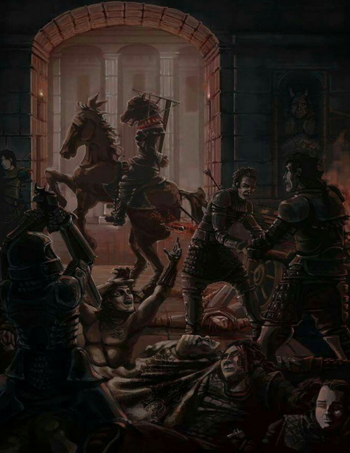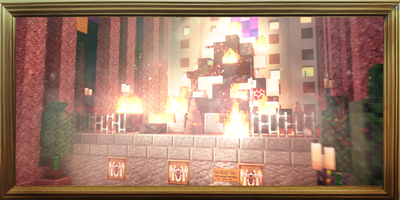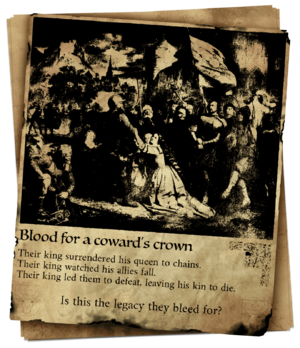The Red Coronation
| THE RED CORONATION | ||||
|---|---|---|---|---|
| Part of the Aevos Coalition War | ||||
| ||||
The Red Coronation, a term now synonymous with betrayal and calamity, refers to the ill-fated coronation of Queen Sybille in the Kingdom of Balian. Its infamy stems not only from the catastrophic events of the day itself but also from the subsequent proliferation of songs, tales, and artworks. These cultural artifacts, often laced with mockery and scorn, have been instrumental in documenting and shaping perceptions of what many on the sides of Veletz and Krug view as the beginning of a doomed reign. Central to these narratives is the dramatic and ignominious flight of Queen Sybille, along with the Pontiff, through hidden tunnels, fleeing the oncoming battle and the men and women of the ceremony, who were encouraged to fight for her cause. This act of desertion earned Queen Sybille a derisive nickname within Veletz's Coalition that has since become emblematic of her reign: the Queen Who Ran. This moniker, seeped in mockery, encapsulates the collective contempt and disillusionment felt by those who witnessed or learned of her flight. For the forces of Veletz and The Iron Horde, however, this nickname and the event itself were a source of jubilation, seen as a decisive victory and a symbol of their dominance.
In Popular Culture
The aftermath of the Red Coronation saw a cultural explosion in the form of tales, songs, symbolic figurines, and art pieces, all symbolizing and often mocking the event and Queen Sybille's role in it. A notable example of this cultural response is a song performed by an anonymous Musin bard in The Blurry Uzg.
| The Ballad of the Fleeing Queen | |
|---|---|
|
The Ballad of the Fleeing Queen. Oh, hear the tale of Sybille the Queen, With a crown so bright and a court so keen. In Balian's halls, she stood so grand, Till Veletz and Krug stormed the land.
Sing hey! For the Queen Who Ran away, In the tunnels dark, she did stray. Left her throne in a fiery blaze, Oh, sing the tale of her fleeing days!
The Covenant gathered, swords in hand, To defend the throne, to make their stand. But as the foes through the gates did swarm, Our queen fled the battle, breaking the norm.
Sing hey! For the Queen Who Ran in fright, Through shadowed paths, out of sight. Her people fought, but she took flight, In the annals of shame, she's a blight!
With the Pontiff close, through the dark they tread, While behind them lay the loyal dead. The throne of Balian, in embers red, A tale of a queen, by fear led.
So sing hey! For the Queen Who Ran away, Her crown unclaimed on that fateful day. In taverns, we mock, in songs we say, The Queen Who Ran, in history lay!
Now raise your cups, let the ale flow free, For the Queen Who Ran, from sea to sea. In jest and jibe, forever she'll be, The fleeing monarch, in memory!
| |
| The Balian Crown | |
|---|---|
|
The Balian Crown. Oh, Balian, is a beautiful country, Way, hay, roll and go. And we rolled all night, And we rolled all day, To raid the Balian Crown.
Way, hay, roll and go. But without her crown, who will back her? Way, hay, roll and go. And we rolled all night, And we rolled all day, To raid the Balian Crown
Well, her father was an old adulterer. Way, hay, roll and go. And we rolled all night, And we rolled all day, To raid the Balian crown.
Way, hay, roll and go. Such a shame fire does too Way, hay, roll and go. And we rolled all night, And we rolled all day, To raid the Balian Crown
Way, hay, roll and go.
Way, hay, roll and go. And we rolled all night, And we rolled all day, To raid the Balian Crown. And we rolled all night, And we rolled all day, To raid the Balian Crown.
| |
Similarly, artists and sculptors took to their crafts to immortalize the event, often highlighting the contrast between the grandeur expected of a coronation and the grim reality that ensued. Paintings depicting the raid, with vivid reds and chaotic scenes, found their way into galleries and private collections, serving as a visual reminder of the day's tumultuous events. Meanwhile, sculptors crafted figurines, some satirical in nature, showing a caricatured Queen Sybille fleeing in disarray, which became popular collectibles among the public.
The impact of the Red Coronation on popular culture also extended to festivals and public ceremonies. Mock coronations, symbolizing Queen Sybille's flight, became a common feature in certain taverns, such as The Blurry Uzg, often accompanied by jesters and actors reenacting the escape. Additionally, many Orcs tattooed images of the Queen running away from them on their bodies as a form of mockery and to show the power of their people. These events served both as a form of entertainment and as a public catharsis, allowing people to collectively process and react to the historical event in a communal setting.


